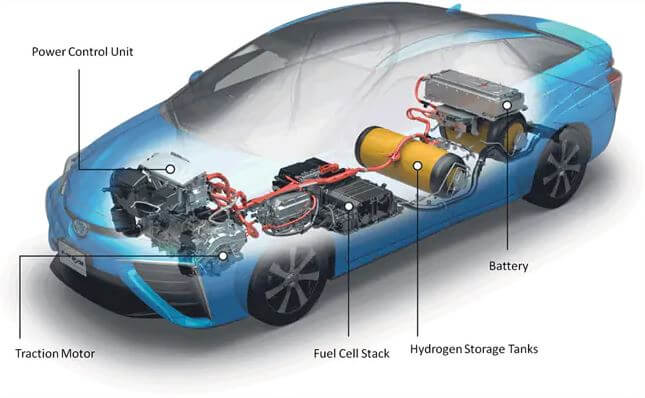Heres a look at how electric vs. In a PEM fuel cell an electrolyte membrane is sandwiched between a positive electrode cathode and a negative electrode anode.
Fuel Cell Electric Vehicles The Driven Motion Blog
Fuel cell vehicles FCVs have an electric motor that is powered using hydrogen gas.

What is a fuel cell car. Weve taken a closer look at how they work and whether theyre worth considering now. IC engine cars fuel will keep on burning for a longer duration which will pose more threat to the people stuck inside. The most common type of fuel cell for vehicle applications is the polymer electrolyte membrane PEM fuel cell.
Fuel cell cars stack up. A fuel cell vehicle FCV is an electric car powered by a fuel cell FC. A fuel cell produces electricity by means of electrochemical reactions between a fuel typically hydrogen and the oxygen in the air.
The fuel cell and its control unit live where youd find the engine in a combustion engine car and under the floor. Because energy conversion efficiency of FC itself is high high energy efficiency can be expected as a whole. Fuel Cell Electric Vehicle FCEV also known as Fuel Cell Vehicle FCV or Zero Emission vehicle.
In contrast the electricity for a BEV is generated outside the vehicle and stored in the vehicles battery pack. Hydrogen fuel cell cars are hailed by some as the future of motoring. However the cars dont burn the fuel like traditional gasoline or.
It is a type of electric vehicle that employs fuel cell technology to generate the electricity required to run the vehicle. Fuel cell cars use hydrogen to generate electricity so how much do they cost and should you buy one. There was a test that had live gunfire shot at the hydrogen tank in.
Because energy conversion efficiency of FC itself is high high energy efficiency can be expected as a whole. In these vehicles the chemical energy of. Although its an electric vehicle there is never a need to charge the car with a plug.
You fill up with hydrogen fuel in the same way as gasoline or diesel at a filling station. The fuel-cell electric vehicle FCV is at its most basic level an electric vehicle EVIt has at least one electric motor powering the drive wheels. The Toyota Fuel Cell System used in Mirai produces electricity from a reaction between hydrogen and oxygen in a fuel cell stack with no tailpipe emissions other than water vapour.
With this in mind this infographic from First Aid Wheels is designed to assist you with learning about two sustainable car fuels and how each can contribute to the future of green motoring. Youll learn the benefits and essential sustainability features to consider. A fuel cell generates electricity through an electrochemical reaction of hydrogen and oxygen that occurs within the vehicle itself.
An electric car that is fuelled by hydrogen so doesnt need to have its batteries charged from the mains. Like a battery-electric vehicle it also has a big-ass battery most likely a lithium-ion job although the Toyota Mirai makes do with Toyotas favourite battery technology nickel-metal hydride. How Fuel Cells Work.
A fuel-cell vehicle FCV such as the Clarity Fuel Cell is a long-range all-electric vehicle that uses a fuel-cell stack to create electricity on demand. Broadly speaking that is what a fuel cell car is. So a big advantage of FCEVs versus BEVs is fuel cells dont require recharging like batteries.


